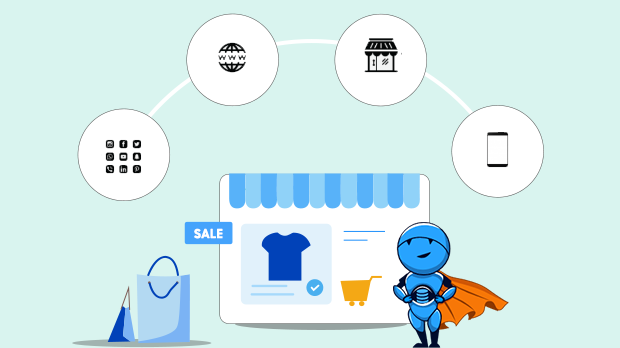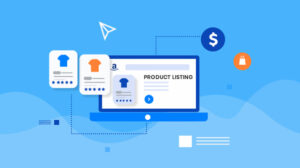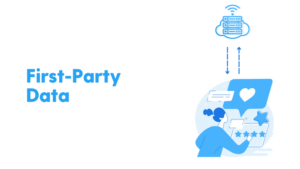Customers in today’s retail landscape anticipate a smooth experience regardless of whether they begin their search on a mobile device or a desktop computer and decide to purchase an item online or in-store. Therefore, a seamless transition across channels is the goal of every successful omnichannel retail strategy. Now more than ever, an omnichannel approach is essential for successful retail operations. Consumers use multiple channels to learn about a brand’s products, find deals, or compare pricing. Brands that grasp omnichannel retail will have a far easier time reaching these shoppers. Continue reading to learn more about Omnichannel retail and how to make an omnichannel retail strategy.
What is Omnichannel Retail?
When we talk about “omnichannel retail,” we are referring to the system of interconnected channels that makes shopping a breeze. The goal of an omnichannel, customer-focused retail strategy is to provide a consistent and positive customer experience across all channels of communication. To interact with your company, customers can pick a variety of channels. For example, they could stroll into a store to try it out in person, contact you through mobile devices, engage in face-to-face conversation, or leave a comment on a social networking site. Providing seamless service across all channels is key to maintaining loyal customers and reaping the benefits of an omnichannel strategy.
The eCommerce industry can now offer bespoke shopping experiences thanks to omnichannel retail. Omnichannel shopping provides a unified experience for consumers whether they purchase in a physical store or exclusively online.
Benefits of Omnichannel Retail
Both customers and stores benefit from an omnichannel approach to shopping. Along with ensuring a smooth experience, this tactic also fortifies sales channels, which boosts income via customers’ active participation. In addition to striving for a single platform for retail success, omnichannel retailers take advantage of and adapt innovative technologies to streamline the shopping experience for their customers.
The following are some more advantages of omnichannel retail that should not be overlooked:
Observe and Adapt to Customers
What customers decide to buy from you will determine your firm’s success. To succeed in the competitive retail environment, you must spend a lot of time researching and analyzing the market for your target demographic. Constant consumer feedback, mapping of behavioral patterns across digital and physical businesses, and questions to the customer support team all help narrow the pool of potential buyers to a more manageable size. Online consumer evaluations and word of mouth become your closest friend when introducing new items, enhancing functionality, and adopting new technological experiences. Providing your consumers with the tools they may want is as simple as providing them with an omnichannel experience.
Simplify Operations for Omnichannel
What do you think your clients want? What are their favorite channels? An omnichannel strategy gives you more leeway to respond to changing customer preferences and habits. The best way to determine which channels your consumers like and are most likely to interact with is to review your customer data and readjust your priorities regularly.
- Pay attention to the flow of traffic on each channel.
- Create a self-service portal with an associated knowledge base. Identify the channels in which you wish to invest. Allocate the necessary resources (time, money, and equipment)
- Distribute information using all accessible means
- Get your customer service staff trained.
Use an omnichannel approach to always be there for your clients. Help them out, keep an eye on how they are behaving, and shift gears if you find that you need to.
Personalize Your Customer Interactions
Let us begin by establishing communication amongst the various channels. You may have started as a store with just one location, but now you are a multichannel retail phenomenon. When the time was right, you shifted to an omnichannel approach to retail. Think about how much information you need to track and how you wish you had a single dashboard. Using Omnichannel is an excellent place to begin. With Omnichannel, you can provide a more tailored experience for your customers, thanks to its easy-to-use interface, intelligent automation bolstered by top-tier AI, and consistent feel across your support channels.
Empower Your Support Teams
Let auto-route reduce stress for your support staff by centralizing tedious data reporting and streamlining operations from one convenient dashboard. People who like their jobs are likelier to provide excellent service to their clients. Delight your clientele using AI-driven chatbots to offer instantaneous support whenever, wherever, and on whatever platform they like. You can also see how each support representative on your team has helped boost customer happiness with Omnichannel, making it easier to manage team performance.
Challenges of Omnichannel Retail
When it comes to the online shopping experience, omnichannel retailing takes a comprehensive approach. As a result, your consumers will get the same excellent experience no matter where they are located.
Marketing
The actual test for marketers is in the creation of individualized customer experiences. Customers enjoy having options and may engage with a business in several ways, including traditional brick-and-mortar locations, smartphone applications, and social media. Therefore, collecting data from all these channels on a single platform is necessary to enable hyper-personalization and boost consumer happiness. For example, sending out an email alerting consumer about a deal or other event may be a terrific way to get them to engage with your business and make a purchase, especially if they have been on the fence about making a purchase or have abandoned their carts.
Sales
Once the marketers have determined what customers want and analyzed consumer behavior, they may help the sales teams tailor offers to individual customers based on their past purchases. Then, in-store salespeople and online merchants may adopt a similarly personalized approach.
For instance, purchasing eyewear has often been done in a physical store. Customers may be hesitant to acquire anything that would improve their daily work lives without first trying it on, seeing how it fits, and deciding if it is in line with their aesthetic. When looking for new eyeglasses, customers go through a certain sequence of steps, including learning about the quality of the lenses, providing their prescription, and selecting the appropriate frame size, style, and brand.
Services to Customers
Retailers must move away from data siloes and toward a centralized data management system that can handle data on products, new products, and customer behavior. This may improve store inventory management and help businesses provide better customer service. When sales and marketing departments collaborate with customer service to create customized client journeys, a positive Customer Experience is secured. Customers may require help during their unique trip, whether regarding the services they have used, the item they have purchased, or the brand’s rules. This is where support staff comes in. A great example of a company that puts the customer first is Walgreens, which uses an omnichannel retail strategy to provide excellent service to its clientele.
Steps for Building an Omnichannel Strategy
Orchestration is the process of coordinating all your marketing and sales efforts so that each consumer has a consistent and seamless experience across all your channels.
Each company’s omnichannel strategy implementation is different since each firm picks its mix of sales and marketing channels based on its own unique aims and objectives. Accordingly, your methods will differ from one another to accommodate your specific requirements.
Segment your customers
Many methods exist for client segmentation; it is up to you to find the one that best serves your company’s needs. However, the purpose of market segmentation, or dividing your target market into smaller subsets, is better to tailor your product or service to each subgroup.
How is this helpful?
Marketers that take the time to divide their clientele into smaller groups are more likely to have success than those who adopt a blanket approach.
These are some of the criteria that some retailers use to divide up their clientele:
- The scale of earnings.
- Location on the map.
- Generation (e.g., millennial, Gen X).
- The way people act in cyberspace.
- Values.
- Interactions with promotional efforts.
- After you have separated your customers into several groups, you may tailor your offer to each of them.
Determine which channels each customer segment uses
Retailers of varying sizes and demographics embrace new channels in remarkably consistent ways. They often cast the widest net at the outset (Amazon, Google, Facebook), but as they expand, they begin to specialize in niche markets, such as Mercado Libre for Latin America and the Caribbean, Snapchat, and TikTok for the millennial generation, etc.
Suppose you are interested in purchasing a gold wristwatch. Depending on the style of timepiece you are trying to find, you have an infinite number of potential sources to investigate. Are you searching for a pre-owned, rare, or antique timepiece? You may be thinking about visiting eBay.
If your taste is trendier and fashion-forward, you may surf Instagram for suggestions. Are you in search of the finest? The jewelry may look better and feel better in person, so you should visit a physical store. That is true regardless of the type of product or intended audience. Knowing a consumer’s browsing habits, purchasing habits, and what inspires them to make a purchase can help you approach them at the appropriate time and in the right location.
Quantitative and qualitative data combined can help you make educated choices regarding your most valuable channels. For example, speaking with consumers may heighten your understanding of their needs and offer you a deeper understanding of what it is like to be in their shoes. However, tracking KPIs (Key Performance Indicators) will fill out the image you are building in your head.
You may use analytics to find out which channels bring in the most revenue, the most satisfied consumers, or both. Then, invest most of your attention in creating the best possible purchasing experience on and among those channels.
Map the consumer journey
However, knowing your clients and their preferred shopping channels is just part of the picture. The ‘why’ and ‘how’ of client behavior are crucial for businesses to understand.
Customers’ mental processes may be uncovered through customer journey mapping, which also helps businesses see what is working and what is not.
Let us revisit that gold watch and assume you are trying to find the most modern version of it. The path from first interest to final purchase may look something like this:
- You may Google “gold watches” or look it up on Pinterest.
- Take the time to investigate the Instagram accounts of a few interesting companies.
- You will see retargeting advertising for various jewelry manufacturers, some of which you may choose to click on.
- Join the mailing lists of a few brands you like.
- Look up “[brand name] reviews” to find some recommendations.
- Select a final selection and buy it from the brand’s online store.
Even though there are innumerable opportunities for the trip to be rerouted or rearranged at any given point, the consumer is still entitled to expect a smooth ride. That is a significant obstacle to multichannel marketing. An effective strategy involves an in-depth understanding of what customers genuinely want, as this McKinsey article emphasizes: “Since customer journeys aren’t straightforward and linear but a series of handoffs between conventional and digital channels that might vary dramatically by customer type.”
Provide cross-channel customer assistance
Modern buyers expect to make purchases and get help in whichever way is most practical for them. So, if you commit to being accessible across various mediums, your customer service needs to be prepared to adapt accordingly.
Just take this as an illustration:
A buyer discovered a product through a Facebook ad, explored the ad’s CTA, and purchased the item from the seller. Unfortunately, the link they selected is now inoperable.
They were looking for that precise item but were unable to locate it. So, to whom are they turning for help? Which is more likely: Facebook or the actual supplier?
- If the customer service teams are not cohesive, the consumer can feel abandoned and decide not to buy the goods, which would be bad for business.
- Businesses may avoid these problems and assist all customers at any point in their customer journey and over any channel by implementing a cross-channel customer care system.
- Customers’ lifetime values and loyalty may rise if you give them reliable, consistent service.
Integrate Your technology
Inventory management is a prime example of why it is important to integrate as much of your technological stack as feasible.
You will need a consolidated, real-time picture of all your stock whenever you begin selling through several channels. To avoid duplicating product data entry across all your sales channels, you should use a PIM or similar solution as a centralized hub for all your product data.
Using an ELT, no-code, eCommerce-focused data pipeline like Daton, you can connect and bring your accounts across marketplaces like Amazon, eBay, Google, and Walmart, and centralize your data.
The advantages will persist in the future. Integrating your marketing and e-commerce strategies allows you to gather the most crucial data in one place, making it easier to evaluate results and spot openings. As a bonus, having a smooth transition across channels is excellent for customer service. To continue the conversation started by email with a specific customer, it would be helpful if your phone representative had access to the entire thread. According to a recent article by McKinsey, “Advanced analytics and new technology, such as detecting difficulties before the consumer explains the cause for the contact, allow first movers to produce ‘wow moments.'”
Take Advantage of Automation
Here are a few examples of how automation can help with omnichannel retail.
- Implement a chatbot to handle simple client inquiries, and free up support staff to deal with more complex problems.
- The ability to observe your business in real time and make decisions based on aggregated data depends on your technology stack’s quality.
- Make sure potential buyers receive the correct messages at the right moments by setting up behavioral triggers to offer more targeted marketing across the customer journey.
- A customer’s abandoned cart may be accessed through every channel they interact with your business, and abandoned cart programs are a wonderful way to get them back and finish their purchases.
- The automated follow-up messages might express gratitude for the purchase and provide incentives for more investments (like a discount) for the consumer.
Make testing a habit
Testing is an ongoing process, not just something that happens in the last days before a release. Because of the complexity of an omnichannel journey, your company should have a well-established testing procedure.
Continuous testing is essential for omnichannel retail, and it should cover every facet of your site, from desktop browser testing (to see how consumers use your shop and make purchases) to software testing (to evaluate how your site responds to customers’ choices).
Keep testing and keep testing everything. You should try out various combinations of subject lines, content, style, offers, etc. Try out your segments to see if you can go more specific with your targeting.
At some point, testing should be transformed into an automated process that provides continuous feedback on the health of your organization and suggestions for where to make changes. To make the choices that will take your company to the next level, collecting data at every customer touchpoint will be essential. Having a platform and solutions partners that simplify the collection of data from multiple sources and the extraction of meaningful insights is essential.
Conclusion
Customers have come to demand a uniform, omnichannel buying experience. As a result, today’s businesses must constantly adjust to meet the changing demands of their customers and fine-tune their knowledge of their demographic. There ought to be no gaps or omissions in an omnichannel plan of action. The four cornerstones upon which the business rests are sales channels, marketing, advertising, operations, and shipping and fulfillment.













